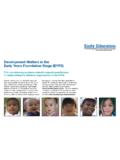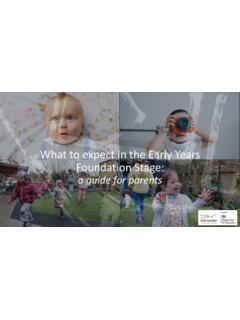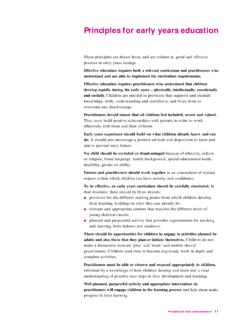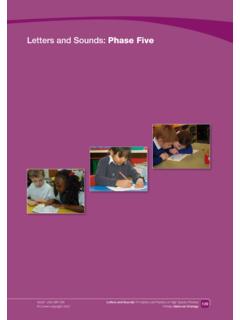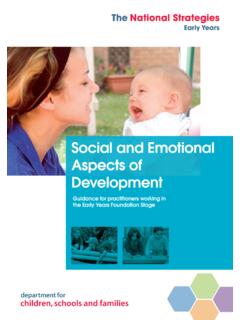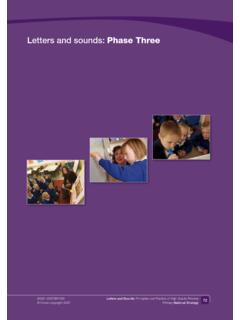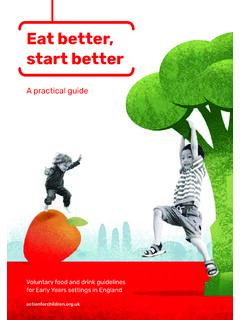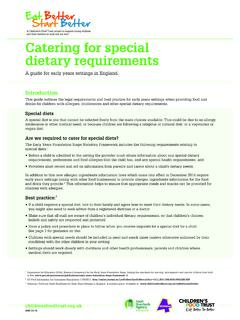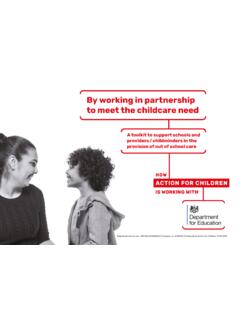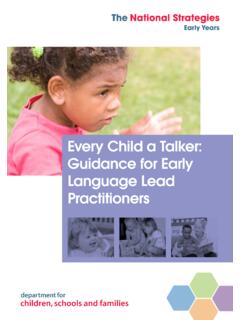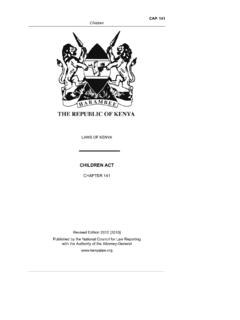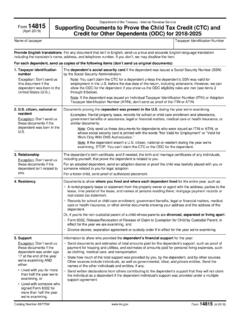Transcription of SEN and disability in the early years: A toolkit
1 SEN and disability in the early years: A toolkit Section 10 Transitions Page 1 of 7 Section 10: Transitions for disabled children and children with SEN This section of the toolkit is about transitions for disabled children and children with SEN: from home into an early years setting; changing between providers; or moving from a setting into school. It is important that when children start in a setting, move on to another setting or to school, that they have the best possible chance of a smooth transition and a successful placement. Transition for all children Transitions should be seen as a process not an event, and should be planned for and discussed with children and parents.
2 Settings should communicate information which will secure continuity of experience for the child between settings. early Years Foundation Stage Practice Guidance, 2008 If transition is a process, the key to its success lies in the preparation and planning beforehand and the settling in, or follow up, afterwards. The voice of the child Transition is a time of change and can be a source of both excitement and anxiety for children and for parents. Throughout the transition process, young children need to feel secure and confident that their needs, wants, likes and dislikes will be understood.
3 early years providers [..] should know precisely where children and young people with SEN are in their learning and development. They should ensure decisions are informed by the insights of parents and those of children [..] themselves. DfE and DH (2015) SEN and disability code of practice: 0-25 years, para Young children are dependent on the adults around them to share this important information. Practitioners and parents should be encouraged to share their observations of children s choices, and the preferences reflected in these, at every stage. Respecting the different ways in which children communicate, toys, pictures, photos of people and settings, creative role play using puppets and dolls in different scenarios, can all be used to promote communication and enable children to express their views.
4 Transition into the setting Planning and preparation for transition may involve a range of different elements, though these are not necessarily separate activities. They are likely to include: establishing relationships sharing information visits creating continuities preparation in the setting training and support settling in and follow up Section 10 Transitions Page 2 of 7 Successful transition for disabled children and children with SEN has its foundation in good practice for all children . Where a child s needs have been identified before they are admitted to the setting, transition is likely to require more detailed planning, the closer participation of parents and the sharing of a wider range of information.
5 The period of planning and preparation is likely to involve the SENCO as well as the allocated key person and, for some children , the involvement a wider range of professionals. Different settings plan transition in different ways and leaders decide how to support the process. In the sections below, it is assumed that the key person is leading the transition process with the support and involvement of the SENCO. At different stages and for different children and families, the SENCO may be more involved. Establishing relationships: Successful transition preparation begins early so that there is time to establish good communication and build a trusting relationship between home and setting by the time the child starts attending the setting.
6 Sharing information: Information is shared through the completion of admissions and registration forms, and well-designed forms can support smooth transitions, but information also needs to be gathered face-to-face in order to benefit from parents insights. The range of information gathered needs to include sufficient detail for the setting to understand the child s stage of learning and development, their likes, dislikes, who and what is important to them, their routines, and, importantly, how the child communicates. Settings can benefit from parents insights into what has really helped and supported their child s learning and development to date.
7 For a child whose needs have already been identified, the setting will want to know which other professionals have already been involved in working with the family, for example a health visitor, a Portage worker or a speech and language therapist. The setting may ask parents to share information from other professionals, and may want to seek parents permission to work with other professionals, to gain a fuller picture of different aspects of the child s development and to better prepare the setting for the child s start there. Settings may encourage parents to gather information in an All about me book, with photos showing important aspects of the child s life: the child involved in a favourite activity; the child using pictures, signs or symbols to communicate; or the detail of how a child with a physical impairment needs to be positioned in order to engage in a particular activity.
8 Settings need to use the period of planning and preparation to gather information to feed into their approach to SEN Support when the child starts attending the setting. Settings should have in mind the discussions they have at different stages of the assess, plan, do, review cycle and should seek to cover as much as they can of assess, and plan so that they can do and review when the child starts, see Section 5: SEN Support in the early Years A Graduated Approach. The other part of information-sharing is about giving parents a good picture of the setting: everything from the setting s approach to teaching and learning to the daily routines.
9 For disabled children and children with SEN it is important that parents understand the setting s approach to SEN and disability , their policies, and their underlying commitment to equality of opportunity and including children in every aspect of the life of the setting. Section 10 Transitions Page 3 of 7 Visits: Visits to the child s home provide an opportunity for the parent to share information in an environment where both they and the child feel more comfortable. For the setting, it will be important: to see the child playing in their own home; to learn from skills or techniques used by parents to support their child at home; to gain an insight into the wishes, views and feelings of the child and of their parents; to gain a fuller picture of the child s stage of learning and development; and to gain insights into how they may need to adapt arrangements in the setting to match or mirror aspects of the home.
10 A home visit is an opportunity to gather much of the information that is needed and to plan for the child s start in the setting. Inviting parents to visit the setting provides an opportunity for parents to consider, with the key person and SENCO, how the child may respond to different aspects of the setting: to different toys and activities; what they may enjoy, what they may find difficult. This is an opportunity for the key person to identify with the parent any reasonable adjustments that may need to be made for a disabled child making reasonable adjustments is an anticipatory duty, so adjustments need to be made before the child could be placed at a disadvantage, see Section 2: Statutory responsibilities.
